BrianKrebs
New Member
- Joined
- Oct 31, 2015
- Messages
- 431
- Reaction score
- 14
Few schemes for monetizing stolen credit cards are as bold as the fuel theft scam: Crooks embed skimming devices inside fuel station pumps to steal credit card data from customers. Thieves then clone the cards and use them to steal hundreds of gallons of gas at multiple filling stations. The gas is pumped into hollowed-out trucks and vans, which ferry the fuel to a giant tanker truck. The criminals then sell and deliver the gas at cut rate prices to shady and complicit fuel station owners.
Agent Steve Scarince of the U.S. Secret Service heads up a task force in Los Angeles that since 2009 has been combating fuel theft and fuel pump skimming rings. Scarince said the crooks who plant the skimmers and steal the cards from fuel stations usually are separate criminal groups from those who use the cards to steal and resell gas.
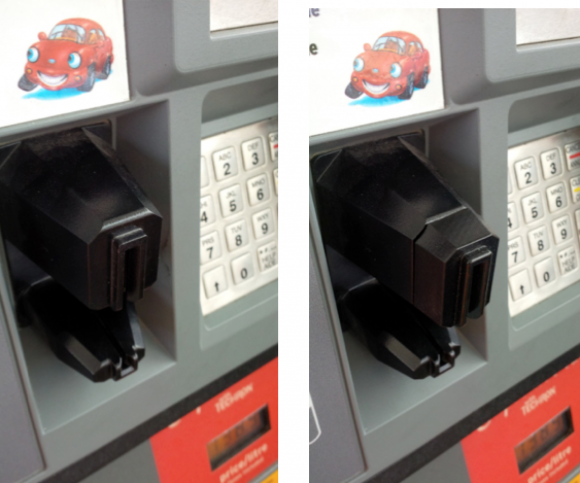
An external pump skimmer is attached to the end of this compromised fuel dispenser in Los Angeles (right).
“Generally the way it works is the skimmer will sell the cards to a fuel theft cell or ring,” he said. “The head of the ring or the number two guy will go purchase the credit cards and bring them back to the drivers. More often than not, the drivers don’t know a whole lot about the business. They just show up for work, the boss hands them 25 cards and says, ‘Make the most of it, and bring me back the cards that don’t work.’ And the leader of the ring will go back to the card skimmer and say, ‘Okay out of 100 of those you sold me, 50 of them didn’t work.'”
Scarince said the skimmer gangs will gain access to the inside of the fuel pumps either secretly or by bribing station attendants. Once inside the pumps, the thieves hook up their skimmer to the gas pump’s card reader and PIN pad. The devices also are connected to the pump’s electric power — so they don’t need batteries and can operate indefinitely.
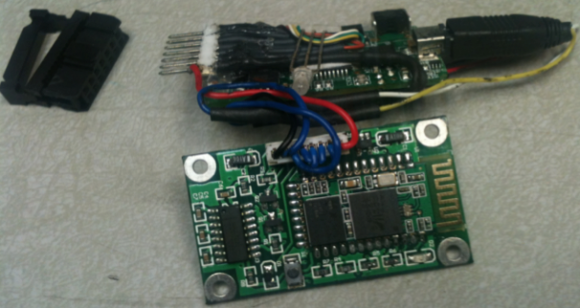
Internal pump skimming device seized from a Los Angeles fuel station.
Most internal, modern pump skimmers are built to record the card data on a storage device that can transmit the data wirelessly via Bluetooth technology. This way, thieves can drive up with a laptop and fill their tank in the time it takes to suck down the card data that’s been freshly stolen since their last visit.
The Secret Service task force in Los Angels has even found pump skimming devices that send the stolen card data via SMS/text message to the thieves, meaning the crooks don’t ever have to return to the scene of the crime and can receive the stolen cards and PINs anywhere in the world that has mobile phone service.
MOBILE BOMBS
Scarince said the fuel theft gangs use vans and trucks crudely modified and retrofitted with huge metal and/or plastic “bladders” capable of holding between 250 and 500 gallons of fuel.
“The fuel theft groups will drive a bladder truck from gas station to gas station, using counterfeit cards to fill up the bladder,” he said. “Then they’ll drive back to their compound and pump the fuel into a 4,000 or 5,000 container truck.”
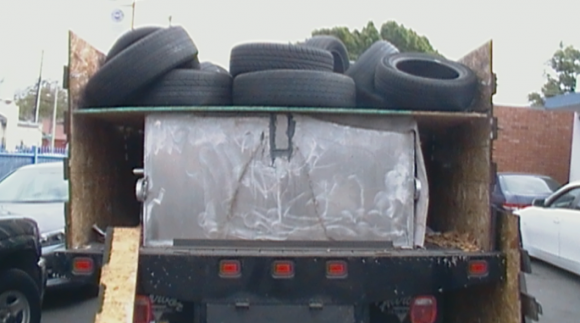
A bladder truck made to look like it’s hauling used tires. The wooden panel that was hiding the metal tank exposed here has ben removed in this picture.
The fuel will be delivered to gas station owners with whom the fuel theft ring has previously brokered with on the price per gallon. And it’s always a cash transaction.
“The stations know they’re buying stolen gas,” Scarince said. “They’re fully aware the fuel is not coming from a legitimate source. There’s never any paperwork with the fuel driver, and these transactions are missing all the elements of a normal, legitimate transaction between what would be a refinery and a gas station.”
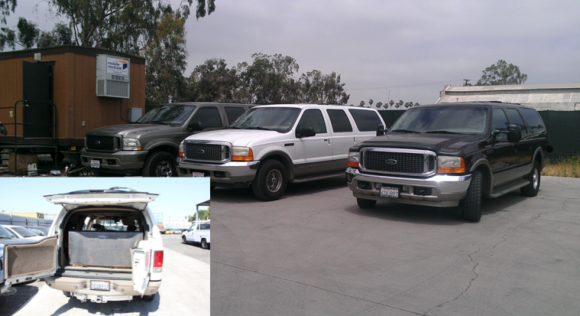
Fuel theft gangs converted this van into a bladder truck. Image: Secret Service.
Needless to say, the bladder trucks aren’t exactly road-worthy when they’re filled to the brim with stolen and highly flammable fuel. From time to time, one of the dimmer bladder truck drivers will temporarily forget his cargo and light up a smoke.
“Two or three summers ago we had this one guy who I guess was just jonesing for a cigarette,” Scarince said. “He lit up and that was the last thing he did.”
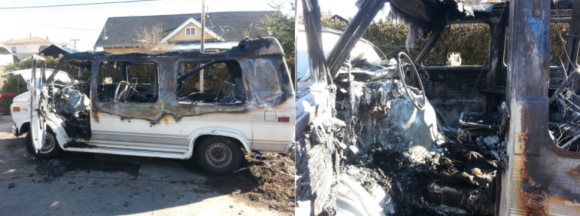
This bladder truck went up in (a) smoke.
Other bladder trucks have spontaneously burst into flames at filling stations while thieves pumped stolen gas.
“There have been other fires that took place during the transfer of fuel, where some static sparked and the whole place caught on fire,” Scarince said. “These vehicles are not road-worthy by any means. Some of the bladder tanks are poorly made, they leak. The trucks are often overweight and can’t handle the load. They fill it up with 300 pounds of liquid, and we see things like transmissions giving out, chassis going out. These things are real hazards just waiting to happen.”
How big are the fuel theft operations in and around Los Angeles? Scarince estimates that at any given time there are 20 to 30 of these deadly bladder trucks trundling down L.A. freeways and side streets.
“And that’s a very conservative guess, just based on what the credit card companies report,” he said.
Aaron Turner, vice president of identity service products at Verifone — a major manufacturer of credit card terminals — leads a team that has been studying many of the skimming devices that the Secret Service has retrieved from compromised filling stations. Turner says there is a huge potential for safety-related issues when it comes to skimmers in a gas-pump environment.
“Every piece of equipment that is installed by gas station owners in the pump area is approved by reviewed and approved according to industry standards, but these skimmers…not so much,” Turner said. “One of the skimmers that we retrieved was sparking and arcing when we powered it up in our lab. I think it’s safe to say that skimmer manufacturers are not getting UL certifications for their gear.”
COUNTERING FUEL FRAUD
With some fuel theft gangs stealing more than $10 million per year, Scarince said financial institutions and credit card issuers have responded with a range of tactics to detect and stop suspicious fuel station transactions.
“A lot more card issuers and merchant processors are really pushing hard on velocity checks,” Scarince said, referring to a fraud detection technique that reviews transactions for repeating patterns within a brief period. “If you buy gas in Washington, D.C. and then 30 minutes gas later gas is being purchased on opposite side of the city in a short period of time. Those are things that are going to start triggering questions about the card. So, more checks like that are being tested and deployed, and banks are getting better at detecting this activity.”
Card issuers also can impose their own artificial spending limits on fuel purchases. Visa, for example, caps fuel purchases at $125. But thieves often learn to work just under those limits.
“The more intelligent crooks will use only a few cards per station, which keeps them a lower profile,” Scarince said. “They’ll come in a swipe two to three cards and fill up 40-80 gallons and move on down the road to another station. They definitely also have what we determine to be routes. Monday they’ll drive one direction, and Tuesday they’ll go the other way, just to make sure they don’t hit the same stations one day after another.”
Newer credit and debit cards with embedded chip technology should make the cards more costly and difficult to counterfeit. However, the chip cards still have the card data encoded in plain text on the card’s magnetic strip, and most fuel stations won’t have chip-enabled readers for several years to come.
On Oct. 1, 2015, Visa and MasterCard put in force new rules that can penalize merchants who do not yet have chip-enabled terminals. Under the new rules, merchants that don’t have the technology to accept chip cards will assume full liability for the cost of fraud from purchases in which the customer presented a chip-enabled card.
But those rules don’t apply to fuel stations in the United States until October 2017, and a great many stations won’t meet that deadline, said Verifone’s Turner.
“The petroleum stations and the trade organizations that represent them have been fairly public in their statements that they don’t feel they’re going to hit the 2017 dates,” Turner said. “If you look at the cost of replacing these dispensers and the number of systems that have been touched by qualified, licensed technicians…most of the stations are saying that even if they start this process now they’re going to struggle to meet that October 2017 date.”
Turner said that as chip card readers take hold in more retail establishments, card thieves will begin targeting fuel stations more intensively and systematically.
“We’re moving into this really interesting point of time when I think the criminals are going to focus on the approaches that offer them the greatest return on their investment,” Turner said. “In the future, I think there will be a liability shift specifically for petroleum stations [because] the amount of mag-stripe-facilitated fraud that will happen in that market is going to increase significantly along with chip card deployment.”
Part of the reason Los Angeles is such a hotbed of skimming activity may be related to ethnic Armenian organized crime members that have invested heavily in fuel theft schemes. Last month, the Justice Department announced charges against eight such men accused of planting skimmers in pumps throughout Southern California and Nevada.
Scarince and Turner say there is a great deal of room for the geographic spread of fuel theft scams. Although the bulk of fuel theft activity in the United States is centered around Los Angeles, the organized nature of the crime is slowly spreading to other cities.
“We are seeing pump skimming now shoot across the country,” Scarince said. “Los Angeles is still definitely ground zero, but Florida is now getting hit hard, as are Houston and parts of the midwest. Technology we first saw a couple of years ago in LA we’re now seeing show up in other locations across the country. They’re starting to pick on markets that are probably less aware of what’s going on as far as skimming goes and don’t secure their pumps as well as most stations do here.”
WHAT CAN YOU DO?
Avoid sketchy-looking stations and those that haven’t started using tamper-evident seals on their pumps.
“The fuel theft gangs certainly scout out the stations beforehand, looking for stations that haven’t upgraded their pump locks and haven’t started using tamper seals,” Scarince said. “If some franchised station decided not to spend the money to upgrade their systems with these security precautions, they’re going to be targeted.”
Scarince says he also tends to use pumps that are closest to the attendants.
“Those are less likely to have skimmers in or on them than street-side pumps,” he said.
Consumers should remember that they’re not liable for fraudulent charges on their credit or debit cards, but they still have to report the phony transactions. There is no substitute for keeping a close eye on your card statements. Also, use credit cards instead of debit cards at the pump; having your checking account emptied of cash while your bank sorts out the situation can be a huge hassle and create secondary problems (bounced checks, for instance).
Continue reading...
Agent Steve Scarince of the U.S. Secret Service heads up a task force in Los Angeles that since 2009 has been combating fuel theft and fuel pump skimming rings. Scarince said the crooks who plant the skimmers and steal the cards from fuel stations usually are separate criminal groups from those who use the cards to steal and resell gas.

An external pump skimmer is attached to the end of this compromised fuel dispenser in Los Angeles (right).
“Generally the way it works is the skimmer will sell the cards to a fuel theft cell or ring,” he said. “The head of the ring or the number two guy will go purchase the credit cards and bring them back to the drivers. More often than not, the drivers don’t know a whole lot about the business. They just show up for work, the boss hands them 25 cards and says, ‘Make the most of it, and bring me back the cards that don’t work.’ And the leader of the ring will go back to the card skimmer and say, ‘Okay out of 100 of those you sold me, 50 of them didn’t work.'”
Scarince said the skimmer gangs will gain access to the inside of the fuel pumps either secretly or by bribing station attendants. Once inside the pumps, the thieves hook up their skimmer to the gas pump’s card reader and PIN pad. The devices also are connected to the pump’s electric power — so they don’t need batteries and can operate indefinitely.

Internal pump skimming device seized from a Los Angeles fuel station.
Most internal, modern pump skimmers are built to record the card data on a storage device that can transmit the data wirelessly via Bluetooth technology. This way, thieves can drive up with a laptop and fill their tank in the time it takes to suck down the card data that’s been freshly stolen since their last visit.
The Secret Service task force in Los Angels has even found pump skimming devices that send the stolen card data via SMS/text message to the thieves, meaning the crooks don’t ever have to return to the scene of the crime and can receive the stolen cards and PINs anywhere in the world that has mobile phone service.
MOBILE BOMBS
Scarince said the fuel theft gangs use vans and trucks crudely modified and retrofitted with huge metal and/or plastic “bladders” capable of holding between 250 and 500 gallons of fuel.
“The fuel theft groups will drive a bladder truck from gas station to gas station, using counterfeit cards to fill up the bladder,” he said. “Then they’ll drive back to their compound and pump the fuel into a 4,000 or 5,000 container truck.”

A bladder truck made to look like it’s hauling used tires. The wooden panel that was hiding the metal tank exposed here has ben removed in this picture.
The fuel will be delivered to gas station owners with whom the fuel theft ring has previously brokered with on the price per gallon. And it’s always a cash transaction.
“The stations know they’re buying stolen gas,” Scarince said. “They’re fully aware the fuel is not coming from a legitimate source. There’s never any paperwork with the fuel driver, and these transactions are missing all the elements of a normal, legitimate transaction between what would be a refinery and a gas station.”

Fuel theft gangs converted this van into a bladder truck. Image: Secret Service.
Needless to say, the bladder trucks aren’t exactly road-worthy when they’re filled to the brim with stolen and highly flammable fuel. From time to time, one of the dimmer bladder truck drivers will temporarily forget his cargo and light up a smoke.
“Two or three summers ago we had this one guy who I guess was just jonesing for a cigarette,” Scarince said. “He lit up and that was the last thing he did.”

This bladder truck went up in (a) smoke.
Other bladder trucks have spontaneously burst into flames at filling stations while thieves pumped stolen gas.
“There have been other fires that took place during the transfer of fuel, where some static sparked and the whole place caught on fire,” Scarince said. “These vehicles are not road-worthy by any means. Some of the bladder tanks are poorly made, they leak. The trucks are often overweight and can’t handle the load. They fill it up with 300 pounds of liquid, and we see things like transmissions giving out, chassis going out. These things are real hazards just waiting to happen.”
How big are the fuel theft operations in and around Los Angeles? Scarince estimates that at any given time there are 20 to 30 of these deadly bladder trucks trundling down L.A. freeways and side streets.
“And that’s a very conservative guess, just based on what the credit card companies report,” he said.
Aaron Turner, vice president of identity service products at Verifone — a major manufacturer of credit card terminals — leads a team that has been studying many of the skimming devices that the Secret Service has retrieved from compromised filling stations. Turner says there is a huge potential for safety-related issues when it comes to skimmers in a gas-pump environment.
“Every piece of equipment that is installed by gas station owners in the pump area is approved by reviewed and approved according to industry standards, but these skimmers…not so much,” Turner said. “One of the skimmers that we retrieved was sparking and arcing when we powered it up in our lab. I think it’s safe to say that skimmer manufacturers are not getting UL certifications for their gear.”
COUNTERING FUEL FRAUD
With some fuel theft gangs stealing more than $10 million per year, Scarince said financial institutions and credit card issuers have responded with a range of tactics to detect and stop suspicious fuel station transactions.
“A lot more card issuers and merchant processors are really pushing hard on velocity checks,” Scarince said, referring to a fraud detection technique that reviews transactions for repeating patterns within a brief period. “If you buy gas in Washington, D.C. and then 30 minutes gas later gas is being purchased on opposite side of the city in a short period of time. Those are things that are going to start triggering questions about the card. So, more checks like that are being tested and deployed, and banks are getting better at detecting this activity.”
Card issuers also can impose their own artificial spending limits on fuel purchases. Visa, for example, caps fuel purchases at $125. But thieves often learn to work just under those limits.
“The more intelligent crooks will use only a few cards per station, which keeps them a lower profile,” Scarince said. “They’ll come in a swipe two to three cards and fill up 40-80 gallons and move on down the road to another station. They definitely also have what we determine to be routes. Monday they’ll drive one direction, and Tuesday they’ll go the other way, just to make sure they don’t hit the same stations one day after another.”
Newer credit and debit cards with embedded chip technology should make the cards more costly and difficult to counterfeit. However, the chip cards still have the card data encoded in plain text on the card’s magnetic strip, and most fuel stations won’t have chip-enabled readers for several years to come.
On Oct. 1, 2015, Visa and MasterCard put in force new rules that can penalize merchants who do not yet have chip-enabled terminals. Under the new rules, merchants that don’t have the technology to accept chip cards will assume full liability for the cost of fraud from purchases in which the customer presented a chip-enabled card.
But those rules don’t apply to fuel stations in the United States until October 2017, and a great many stations won’t meet that deadline, said Verifone’s Turner.
“The petroleum stations and the trade organizations that represent them have been fairly public in their statements that they don’t feel they’re going to hit the 2017 dates,” Turner said. “If you look at the cost of replacing these dispensers and the number of systems that have been touched by qualified, licensed technicians…most of the stations are saying that even if they start this process now they’re going to struggle to meet that October 2017 date.”
Turner said that as chip card readers take hold in more retail establishments, card thieves will begin targeting fuel stations more intensively and systematically.
“We’re moving into this really interesting point of time when I think the criminals are going to focus on the approaches that offer them the greatest return on their investment,” Turner said. “In the future, I think there will be a liability shift specifically for petroleum stations [because] the amount of mag-stripe-facilitated fraud that will happen in that market is going to increase significantly along with chip card deployment.”
Part of the reason Los Angeles is such a hotbed of skimming activity may be related to ethnic Armenian organized crime members that have invested heavily in fuel theft schemes. Last month, the Justice Department announced charges against eight such men accused of planting skimmers in pumps throughout Southern California and Nevada.
Scarince and Turner say there is a great deal of room for the geographic spread of fuel theft scams. Although the bulk of fuel theft activity in the United States is centered around Los Angeles, the organized nature of the crime is slowly spreading to other cities.
“We are seeing pump skimming now shoot across the country,” Scarince said. “Los Angeles is still definitely ground zero, but Florida is now getting hit hard, as are Houston and parts of the midwest. Technology we first saw a couple of years ago in LA we’re now seeing show up in other locations across the country. They’re starting to pick on markets that are probably less aware of what’s going on as far as skimming goes and don’t secure their pumps as well as most stations do here.”
WHAT CAN YOU DO?
Avoid sketchy-looking stations and those that haven’t started using tamper-evident seals on their pumps.
“The fuel theft gangs certainly scout out the stations beforehand, looking for stations that haven’t upgraded their pump locks and haven’t started using tamper seals,” Scarince said. “If some franchised station decided not to spend the money to upgrade their systems with these security precautions, they’re going to be targeted.”
Scarince says he also tends to use pumps that are closest to the attendants.
“Those are less likely to have skimmers in or on them than street-side pumps,” he said.
Consumers should remember that they’re not liable for fraudulent charges on their credit or debit cards, but they still have to report the phony transactions. There is no substitute for keeping a close eye on your card statements. Also, use credit cards instead of debit cards at the pump; having your checking account emptied of cash while your bank sorts out the situation can be a huge hassle and create secondary problems (bounced checks, for instance).
Continue reading...
